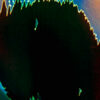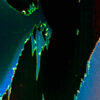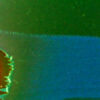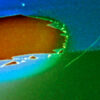Known as the longest kiss in history, al-Mugran is a place of natural beauty and romantic symbolism where the calm and clear waters of the White Nile from the south meet the muddier, darker and rushing waters of the Blue Nile from the east. Al-Mugran’s name comes from Arabic for ‘the junction’ or ‘the confluence’, where, after ‘kissing’, the differently colored battling currents remain visible before flowing united.
Sudan – Africa and the Arab world’s largest country before the secession of South Sudan in 2011 – has struggled since its independence in 1956 from Britain and Egypt to reach long lasting reconciliation. A diverse country dominated by politicians from its north and center, governments have exchanged hands several times between civilians and the military. As armed rebellions and wars have erupted in its less developed peripheral regions, urban protests and uprisings have challenged dictatorships in the center. Endless debates over identity and how to govern the country have dominated the country’s politics.
April 2022 marked my first visit to my ancestral homeland in seven years. I had previously worked in the country from 2007 to 2015 as a freelance journalist for the New York Times and other media outlets. Months earlier, a military coup against a civilian-led transitional government in October 2021 had derailed Sudan’s negotiated democratic transition following a nonviolent revolution in 2019 that brought down thirty years of authoritarian rule. Later, in April 2023, fighting between two branches of the Sudanese military establishment, the Sudanese Armed Forces, the army, and the Rapid Support Forces, a paramilitary, further pushed the country into an abyss of uncertainty. I had written about Sudan’s December Revolution from afar as I could not be in the country for pressing reasons, including attending to a sick father in Washington DC.
Two days before my fiftieth birthday, I went to where many small motor river boats bank along the Blue Nile beneath the Tuti Island bridge, the densely populated island that sits at the confluence of the two rivers between the three cites of the triangular capital: Khartoum, Omdurman and Khartoum North. A young man, Haneen, whose Arabic name means ‘compassion’, approached me. I asked about the fare to rent a boat and he responded, ‘fifteen thousand Sudanese pounds ($27 USD) for a thirty-minute ride to al-Mugran and back or thirty thousand pounds ($54 USD) for a one-hour ride around Tuti.’ I explained that I would like a ride to the confluence to stay there for some minutes then return. He agreed and I took his number and said I would call him the night before to confirm. Haneen then descended from the top of the riverbank as several young men and women, university students, began to fill his boat. Adjusting his outboard motor and slowly proceeding, he then took them to out to the river for an afternoon ride. At the same moment another boat came in and docked. It caught my attention.
This boat was painted in the tri-horizontal colors of Sudan’s independence flag: blue, yellow and green, representing the Nile, the desert and the fertile land. In my mind, it offered an emblematic image of freedom and possibilities while floating over the mixed waters of the confluence. I approached the young boat operator, Bur’i, and asked about his boat rides and fares. He offered the same types of trips as Haneen and even suggested that I could come early and watch the sunrise as many customers do, especially couples. That seemed to me a perfect choice. At first, Bur’i proposed fares higher than Haneen’s so we debated, but then came to an agreement. I took his number and told him I would confirm Friday night. I failed to cancel with Haneen.
I went back to my studio apartment in the Slavos Building in downtown old Khartoum near the Acropole Hotel. The four-story building, constructed in 1954 and home to the city’s first elevator – which no longer works – is remaining evidence, along with the hotel itself, of Khartoum’s now-vanishing migrant Greek community. I arranged with a taxi driver near the hotel, a somewhat grumpy old man who operates a worn-down 1979 yellow Toyota Corolla, Khartoum’s 1980s signature taxi cabs, to drive me early Saturday morning. I also wanted to attend the day’s first prayers at the break of dawn before the boat ride at Khartoum’s old Farouq Mosque.
I woke early and placed a notebook, two small books and cash in an olive-green canvas crossbody bag. With the collapsing value of the Sudanese pound, World Bank-sanctioned economic reform policies made it sometimes necessary to carry sizable amounts of cash that couldn’t fit in a wallet.
We drove in the dark to the not-so-far Farouq Mosque along El Jamhuriya (The Republic) Street. El Tayeb decided to stay in the car and pray later. News about rising gang-related crimes in Khartoum in recent months including burglaries, muggings and carjackings worried him. I chose the Farouq Mosque, site of the city’s oldest mosque if not in fact site of the city’s first known building, in homage to the town’s spiritual roots. The mosque’s modern name is derived from the name of Egypt’s last king, King Farouq, who constructed the current mosque in the early fifties in an architectural style that resembled that of the mosques of Cairo when in colonial times Sudan was ruled jointly by Britain and Egypt. But the mosque in fact has an older story and like much of Sudan’s history, is overshadowed by Egypt.
Before it was known as the Farouq Mosque, it was the Arbab al-‘Aqa’id Mosque. Named after a religious scholar of ethnic Mahas Nubian roots who lived on Tuti Island. He crossed the river to what would become the village of Khartoum in 1691 and built a small mudbrick khalwa (seminary) and mosque. There he taught and students came from other parts of the region and as far as West Africa as they stopped on their way in haj (pilgrimage) to Mecca. In 1821, Egypt’s Albanian ruler Muhammad Ali Pasha, competing with European powers for empire and glory in the region, dispatched an army southward to occupy what today is Sudan. The site of Khartoum was chosen to be the seat of the Pasha’s rule in the region given its strategic location. The original adobe mosque and seminary were destroyed by the Pasha’s forces during a rebellion. Rebuilt just before Sudan’s independence, the mosque’s history in many ways speaks to the complex relationship between Sudan and Egypt – whose political elite claimed Sudan as part of Egypt – and the debate over narratives and names. It was here I wanted to begin my day of reflection.
After morning prayers, where the imam recited from the Quran in soulful tones, I was driven to Tuti Bridge, near the egg-shaped Corinthia Hotel along the Blue Nile where the Khartoum Zoo once was and where my late father, a wildlife expert, once worked. I paid El Tayeb, and walked toward the riverbank in the dark looking forward to welcoming sunrise. As I looked over from above, I called Bur’i’s cell phone, but he did not respond. I called again and there was no response. I saw a young man on one of the boats and asked him if had seen Bur’i. He shook his head sideways.
I called at least ten times but there was no answer. I was angry. ‘Why do I even bother?’ I asked myself and sighed, in those sometimes justified but occasionally arrogant moments of realization of how those of us from the diaspora and many locals manage appointments and time differently. I didn’t want to miss the sunrise, so I walked to the side of the bridge, climbed the emergency metal stairs and continued to the center of the bridge. I put my arms on the rails, faced east, and watched the sun rise while early morning joggers passed behind me.
From above, I saw a couple of tri-colored boats and thought Bur’i might be there. When I got closer, Haneen, the first young man I had spoken with, saw me.
‘Are you here for the boat?’ he asked.
I explained to him, with some embarrassment, that I was more interested in the tri-colored boats and that’s why I did not call him, and I was looking for Bur’i. Haneen told me he hadn’t seen him, but he could ask the operators of another tri-colored boat to take me to al-Mugran. He threw a stone toward the boats and woke two young men up, Bakri and Ahmad.
In fifteen minutes the two were up and ready and we agreed to go. But first, they had to borrow fuel from another boat. Then they went to get a life jacket for me they had lent to another operator from another boat the night before. The boat was called, ironically, Amreeki (American). As we began the river journey westward, Ahmad played music, first Sudanese youth music in the style of zanig from Khartoum’s working-class outskirts, then Dr. Dre followed by an Afrobeat song. I asked if I could have these moments to myself while I sat in front of the boat, alone.
To my left, corresponding south and west, was the strip of land crucial to the city’s geography and believed to be, in one narration, the origin of the city name: Khartoom, Arabic for ‘elephant trunk’. In sight were some of the city’s iconic buildings, which were constructed during different eras of Sudan’s modern history. The buildings, a hodgepodge of architectural styles with different purposes reflected the competing visions for Sudan over the decades.
From the boat I saw Friendship Hall, a white Chinese-built conference hall adorned with a large model Secretary Bird, the emblem of Sudan. Constructed in the seventies during President Jaafar Nimeiry’s socialist years, for decades across different governments it hosted a variety of social, cultural and political events. Here in 2011, I photographed and heard former South African President Thabo Mbeki give a heart-felt talk titled ‘Sudan in Africa’ days before the referendum that saw Sudan split in two. He spoke calmly, deeply and candidly on the reasons for Sudan’s political woes, including Sudan’s ultimate failure to address diversity and peaceful coexistence, putting many in the audience to tears. It hit me after his talk, like never before, the important role that journalism and a free press have in spotlighting a society’s issues and the consequences of their absence. Up to that point I had been working as a journalist for some years, only temporally in my mind until I pursued studies and a career in academia. It was that day I decided to stick with journalism, recognizing its extended public reach and power.
Continuing on was the Sudan National Museum, a favorite place of mine, built in 1970 and home to artifacts of different eras saved during the UNESCO Save Nubia Campaign in the 1960s. They include several temples that were deconstructed, brought to Khartoum and reassembled piece by piece. It was here as a child during summer vacation visits from abroad that I got hooked on studying history and bought my first book, in Arabic, Tarikh al-Sudan al-Qadim (The Ancient History of Sudan).
Then came the April Gardens, named after Sudan’s 1986 April intifada, the country’s second popular uprising, followed by the green-domed Al-Shaheed (The Martyr) Mosque, established in the 1990s during the rule of Omar al-Bashir’s Islamist government with a name that invoked memories of Sudan’s civil war in its south when the war was imbued with religious overtones. After was the Coral Hotel, once the Hilton, built at a time when Nimeiry’s politics after a failed communist coup shifted to the West, welcoming global enterprise and capitalism. Behind the hotel stood the glossy Greater Nile Petroleum Operating Company tower. Part of an incomplete urban development project, the tower was a reminder of the possibilities along with the impact of US sanctions in response to war crimes in Darfur in 2007 followed by an end to oil boom revenues with the secession of South Sudan and its oil fields four years later.
As we rode, I saw police river boats and asked Bakri, ‘isn’t that the River Police Rescue Unit?’ He replied, ‘yes, but now you also have the office of Intelligence and the Rapid Support Forces there.’
‘The Rapid Support Forces? Really?’ I exclaimed.
‘They have truly baffled us,’ Bakri replied.
During the years of al-Bashir’s dictatorship, it wasn’t uncommon for National Intelligence and Security Services to have spies everywhere in the city. But for the Rapid Support Forces to also share an office with them along with the police, in what seemed like a secondary security unit such as the River Rescue Unit, I found astonishing. The Rapid Support Forces became part of Sudan’s complex military map having evolved from a tribal militia formerly known as the Janjaweed, responsible for atrocities in Sudan’ western region of Darfur in the early 2000s and for breaking up a nonviolent sit-in in 2019 that saw the murder of at least 125 protesters and the rape of dozens. It grew into a semi-independent political and economic power rivaling the official army.
Just before reaching the confluence was the al-Mugran Family Park. It was one of the first places I visited in Khartoum as a child when my family returned to Sudan after my father completed his graduate studies in the United Sates.
I took in the sheer variety of the buildings along the riverbank, built by different governments all claiming to champion Sudan’s path forward. My memories of the Khartoum Zoo, no longer there, where I would sometimes wait with my father after school as a child and once saw him feeding the lions. A man of science, he had wanted me to pursue studies in the natural sciences as well, because, as many perceive, it’s a guarantee for a more secure future. I, however, was interested in the humanities. We had long heated discussions in my high school years and as I was about to head to university. I eventually succumbed to a ‘middle ground’ suggestion to study economics. But it wasn’t where my heart was and at a point, I left my university studies for many years. I wasn’t happy. My childhood visits to the Sudan National Museum engraved in me a love for history which I eventually pursued when I went back to complete my studies. I also enrolled in journalism class which I took to practice during a later visit to Sudan that saw me unexpectedly stay for eight years. Covering South Sudan’s Independence Referendum in 2011 and related events at Friendship Hall swayed me to journalism, ‘the first draft of history’, a profession I love, but am occasionally wary of due to its uncertainties and vulnerabilities. Perhaps my father was right.
As we approached al-Mugran I asked if we could stay in place for a few minutes. I took photos. The meeting of the two different colored rivers joining to create one as the morning sun shone, in my mind resonated with what many of Sudan’s intelligentsia had hoped could reflect Sudan’s cultural realities and aspirations: the meeting, uniting, of African and Arab. I opened my crossbody bag and pulled out a signed book by Sudanese poet Muhammad al-Makki Ibrahim, who immortalized Sudan’s 1964 October Revolution – the first popular uprising against dictatorship in the region – in the poem turned song “Green October”. Ibrahim was one of the Forest and Desert literary movement poets who sought to address and reconcile Sudan’s diversity as a source of richness instead of war. I read a poem quietly to myself:
We will not say ‘no’ to our Arabness or ‘no’ to our Africaness
But accept both together . . .
. . . in tribute to our mixed blood
As we see no shame is such . . .
. . . we will face the world
With our Afro-Arabness
Our khulasi (mixed) roots
And cultural uniqueness
And the demands of politics
Will not deter us from the calls of our blood
And loyalty to our roots
The boat continued down the White Nile beneath the old British colonial bridge, then turned back. In the distance I saw my family’s hometown, old, traditional Omdurman and El Nilein Mosque. An architectural masterpiece, it opened in 1984 during a time when Nimeiry again shifted his politics, this time turning to religion and contributing to a new civil war.
The boat slowly moved eastward to the other bank, to the north, closer to Tuti Island. I couldn’t help but notice the beauty of the mangroves and river flowers-polluted by plastic bottles and bags, one example of the country’s growing environmental woes.
When we arrived back to our starting point, I got off the boat, paid Bakri and Ali, and thanked them. I saw Haneen and told him he saved my day, giving him a generous tip. I advised him to color his boat with the colors of the old independence flag. He laughed.
‘You from the diaspora should advise us what to do and we’ll follow.’
I smiled, but really, it was the other way around. It is astonishing what some ‘compassion’ can do. The resilience, imagination and humility of Sudan’s youth is what gave many in this country and abroad hope for better times.
As I walked to the main street, Nile Avenue, I passed by murals of the 2019 Sudanese Revolution on the Tuti Bridge. There were images of some of its martyrs, desecrated by graffiti slogans in support of the October 2021 coup. I went to a nearby tea-lady to drink traditional Sudanese coffee, jebena. On her small cabinet, almost prophetically, was a scribed teasing sentence in Arabic, ‘the road sometimes brings you and you didn’t intend to come.’ As I sat, a convoy of trucks filled with soldiers passed behind me playing loud military songs. The blasts from motorcycle exhaust pipes made some of us sipping our coffee nervous.
For a year I would occasionally come along this strip along Nile Avenue and to its buildings and catch glimpses of the hope I saw for a better future following the 2019 Sudanese Revolution while wrestling with counter revolution forces. At Friendship Hall, I attended an elaborate journalism awards event, the first of its kind, with a friend. Many old friends and colleagues who I hadn’t seen in seven years came to say hello as we waited for the ceremony to begin. ‘But they really respect you,’ my friend unexpectedly pointed to me, aware of my uneasiness at times as a diaspora son ‘fitting in’. The Sudan National Museum was, to both my sadness and delight, closed for much needed renovations for over a year under UNESCO oversight. It did grab media attention when the statute of Kushite Pharaoh Taharqa, mentioned in the Bible, was moved to another site in the museum. Cafe Shanoda, a riverboat cafe run by a Sudanese Christian family, where I discussed literature with a friend as the smoke of tear gas aimed at the weekly pro-democracy anti-coup protesters drifted not far behind us. A celebration of Sufi music at the nearby Sunut Forest. A breaking of the Ramadan fast at the colonial era Grand Hotel where pictures of former guests Queen Elizabeth, Nelson Mandela and Malcolm X hang on its walls. At al-Mugran, I enjoyed an evening dinner in spring at the recently opened restaurant, Nile Point, and walked to see the confluence closer.
In April 2023, however, the worst fears for those hoping for democracy in Sudan came to be realized. On top of the October 2021 coup, the partnership between the army and the militia fell apart and their guns turned on each other, dragging the country into the unknown. For the first time since 1885, full scale organized armies were fighting in Khartoum. I was trapped in the Slavos building for more than a week, fearful of stray bullets and misguided missile strikes. I, along with over thirty other residents, were finally able to leave the building nine days later. I made it to Egypt. My plans to pick up the pieces, like Sudan after the revolution, were to be on hold again.
Photograph courtesy of the author








